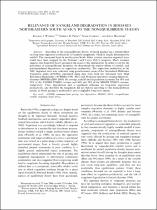 ResearchSpace
ResearchSpace
Relevance of rangeland degradation in semiarid Northeastern South Africa to the nonequilibrium theory
JavaScript is disabled for your browser. Some features of this site may not work without it.
- ResearchSpace
- →
- Research Publications/Outputs
- →
- Journal Articles
- →
- View Item
| dc.contributor.author |
Wessels, Konrad J

|
|
| dc.contributor.author |
Prince, SD

|
|
| dc.contributor.author |
Carroll, M

|
|
| dc.contributor.author |
Malherbe, Johan

|
|
| dc.date.accessioned | 2007-11-15T09:42:07Z | |
| dc.date.available | 2007-11-15T09:42:07Z | |
| dc.date.issued | 2007-04 | |
| dc.identifier.citation | Wessels, KJ et al. 2007. Relevance of rangeland degradation in semiarid Northeastern South Africa to the nonequilibrium theory. Ecological Applications, Vol. 17(3), pp 815-827 | en |
| dc.identifier.issn | 1051-0761 | |
| dc.identifier.uri | http://hdl.handle.net/10204/1609 | |
| dc.description | Copyright: 2007 Ecological Society of America | en |
| dc.description.abstract | According to the nonequilibrium theory, livestock grazing has a limited effect on long-term vegetation productivity of semiarid rangelands, which is largely determined by rainfall. The communal lands in northeastern South Africa contain extensive degraded areas which have been mapped by the National Land Cover (NLC) program. Much evidence suggests that long-term heavy grazing is the cause of this degradation. In order to test for the prevalence of nonequilibrium dynamics, we determined the relative effects of rainfall- and grazing-induced degradation on vegetation productivity. The vegetation production in the NLC degraded areas was estimated using growth-season sums of the Normalized Difference Vegetation Index (RNDVI), calculated using data from both the Advanced Very High Resolution Radiometer (AVHRR) (1985–2003) and Moderate-resolution Imaging Spectroradiometer (MODIS) (2000–2005). On average, rainfall and degradation accounted for 38% and 20% of the AVHRR RNDVI variance and 50% and 33% of the MODIS RNDVI variance, respectively. Thus, degradation had a significant influence on long-term vegetation productivity, and therefore the rangelands did not behave according to the nonequilibrium model, in which grazing is predicted to have a negligible long-term impact. | en |
| dc.language.iso | en | en |
| dc.publisher | Ecological Society of America | en |
| dc.subject | AVHRR | en |
| dc.subject | Communal land | en |
| dc.subject | Grazing | en |
| dc.subject | Land degradation | en |
| dc.subject | MODIS | en |
| dc.subject | NDVI | en |
| dc.subject | Nonequilibrium | en |
| dc.subject | Rainfall | en |
| dc.subject | Rangeland | en |
| dc.subject | South Africa | en |
| dc.title | Relevance of rangeland degradation in semiarid Northeastern South Africa to the nonequilibrium theory | en |
| dc.type | Article | en |
| dc.identifier.apacitation | Wessels, K. J., Prince, S., Carroll, M., & Malherbe, J. (2007). Relevance of rangeland degradation in semiarid Northeastern South Africa to the nonequilibrium theory. http://hdl.handle.net/10204/1609 | en_ZA |
| dc.identifier.chicagocitation | Wessels, Konrad J, SD Prince, M Carroll, and Johan Malherbe "Relevance of rangeland degradation in semiarid Northeastern South Africa to the nonequilibrium theory." (2007) http://hdl.handle.net/10204/1609 | en_ZA |
| dc.identifier.vancouvercitation | Wessels KJ, Prince S, Carroll M, Malherbe J. Relevance of rangeland degradation in semiarid Northeastern South Africa to the nonequilibrium theory. 2007; http://hdl.handle.net/10204/1609. | en_ZA |
| dc.identifier.ris | TY - Article AU - Wessels, Konrad J AU - Prince, SD AU - Carroll, M AU - Malherbe, Johan AB - According to the nonequilibrium theory, livestock grazing has a limited effect on long-term vegetation productivity of semiarid rangelands, which is largely determined by rainfall. The communal lands in northeastern South Africa contain extensive degraded areas which have been mapped by the National Land Cover (NLC) program. Much evidence suggests that long-term heavy grazing is the cause of this degradation. In order to test for the prevalence of nonequilibrium dynamics, we determined the relative effects of rainfall- and grazing-induced degradation on vegetation productivity. The vegetation production in the NLC degraded areas was estimated using growth-season sums of the Normalized Difference Vegetation Index (RNDVI), calculated using data from both the Advanced Very High Resolution Radiometer (AVHRR) (1985–2003) and Moderate-resolution Imaging Spectroradiometer (MODIS) (2000–2005). On average, rainfall and degradation accounted for 38% and 20% of the AVHRR RNDVI variance and 50% and 33% of the MODIS RNDVI variance, respectively. Thus, degradation had a significant influence on long-term vegetation productivity, and therefore the rangelands did not behave according to the nonequilibrium model, in which grazing is predicted to have a negligible long-term impact. DA - 2007-04 DB - ResearchSpace DP - CSIR KW - AVHRR KW - Communal land KW - Grazing KW - Land degradation KW - MODIS KW - NDVI KW - Nonequilibrium KW - Rainfall KW - Rangeland KW - South Africa LK - https://researchspace.csir.co.za PY - 2007 SM - 1051-0761 T1 - Relevance of rangeland degradation in semiarid Northeastern South Africa to the nonequilibrium theory TI - Relevance of rangeland degradation in semiarid Northeastern South Africa to the nonequilibrium theory UR - http://hdl.handle.net/10204/1609 ER - | en_ZA |





